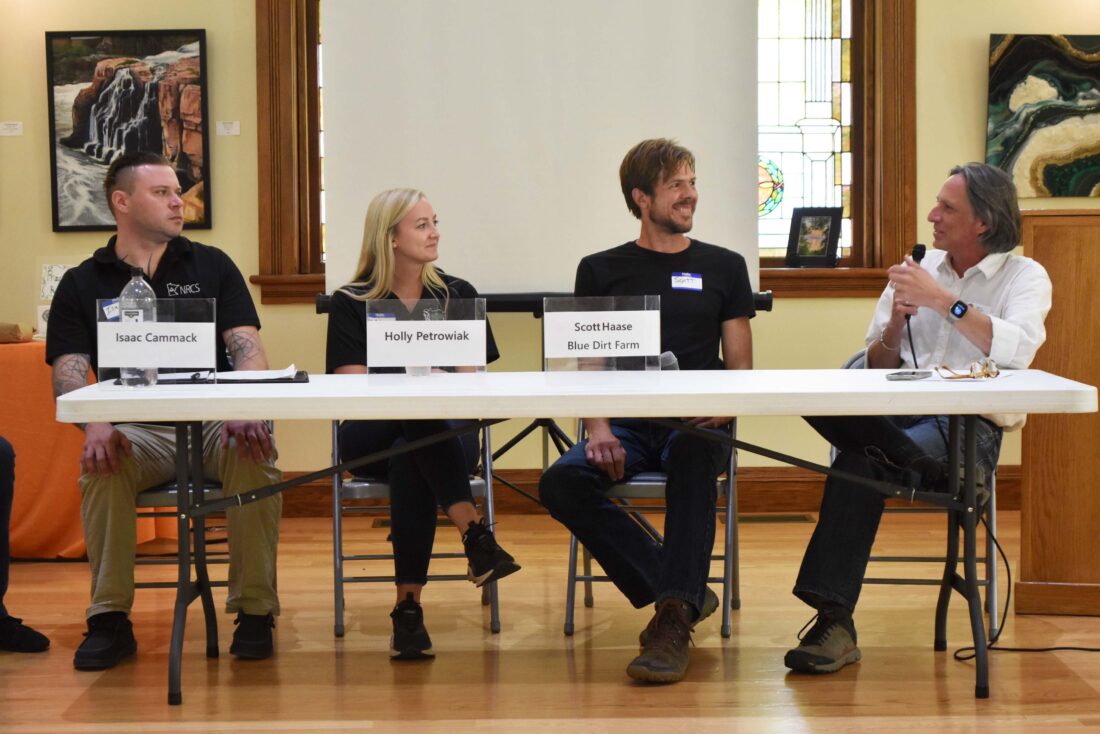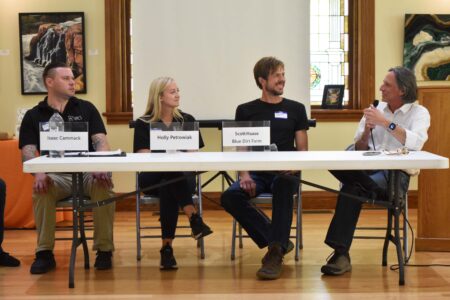Conservation conversation held for farming, land usage

ABOVE: Renewing the Countryside Co-Founder Brett Olson, furthest right. talks about conservation and asks questions of USDA NRCS District Conservationist Patrick Toomey (not pictured), NRCS Representative Isaac Cammack, Martin County Soil and Water Conservation District (SWCD) Conservation Technician Holly Petrowiak and Blue Dirt Farm Owner Scott Haase.
FAIRMONT – The last of eight such talks across Minnesota, Renewing the Countryside brought their conversation on conservation to Martin County at the Red Rock Center in Fairmont on Thursday.
The event was open to local farmers, landowners and community members, allowing them to learn from local experts about land use and conservation. Blue Dirt Farm Owner Scott Haase said the Natural Resources Conservation Service (NRCS) has been a big help for him and his family’s farms over the years.
“We do use some conservation practices there as well,” he said. “NRCS has been helpful in some of that, it’s like a family effort.”
Martin County Soil and Water Conservation District (SWCD) Conservation Technician Holly Petrowiak said she found her position in conservation after graduating during the COVID pandemic.
“You’re learning something new every day based on what people come into our office asking for,” she said. “Looking for help with their animals, their cover crops, what cover crops are, how to be a better conservationist.”
NRCS Representative Isaac Cammack was asked about the Conservation Stewardship Program (CSP) and the Environmental Quality Incentives Program (EQIP). Cammack said one tends to lead into the other.
“EQIP is generally the loan people will start with,” he said. “Maybe your next door neighbor has done some cover crops or no-till practices on their field, and you’re seeing the results. You want to give it a shot, but not do it on everything. Maybe you have 1,000 acres, but you want to do no-till on eight to see what happens over three to five years.”
For those who enjoy the results found under EQIP, they generally move up to the CSP and get all their acres involved. Haase said going under the CSP program helped his family drastically with their soybeans.
“[My father], I give him a lot of credit, because he made one of the first big steps switching our soybeans to no till,” he said. “That was mostly a labor savings thing at the time. Over the 30-some years since he made that change, we’ve come to realize that a little less disturbance in the soil makes a big difference over time.”
Haase said benefits continued even after this initial project, as CSP was able to assist them in switching their full tillage for corn to a strip-till system.
The conversation then shifted to input grants through NRCS for farm conservation projects. USDA NRCS District Conservationist Patrick Toomey said they are cost-shares, not straight-up grants.
“It’s not like typical grant work where you either get the money up front, or you match the money up front and then continue your work, submit your bills, you get that money back,” he said. “Ours is a true cost share. For instance, on fencing, we might plan to put in 15,000 feet of fence. We have a base unit per foot we pay you. Because of topography, for whatever reason that number comes out higher or lower, we pay you for whatever you install.”
Through this arrangement, half of the cost is covered by NRCS, and the other half is paid by the landowner. Toomey stressed that his work with NRCS is as a technical resource for farmers, which is free to use. Through cost-sharing, brand-new materials have to be used. Instead, Toomey said farmers can come to get plans based on their land for free and use what they want.
“Fencing an average corner, I get that out to about 65 bucks a corner,” he said. “If I’m doing it on my own, because I farm, I can do that same corner for about 30 bucks because I’m using used materials. That’s good enough for me.”
The discussion ended by clearing up confusion on which organization to go to for specific programs. Federal conservation programs are under the NRCS, while state programs mainly fall under the SWCD. Petrowiak said thankfully, both organizations have their office at the office building on 923 North State Street, and are happy to answer any questions and direct people where they need to go.
“Our office is always open,” she said. “We do get people that come and just ask, ‘What plant is this growing by me?’ Don’t be scared if you have that question too.”
“Just walk in, there will be somebody in the office and we can talk to you,” Cammack said. “You don’t have to book an appointment out some months or something.”


